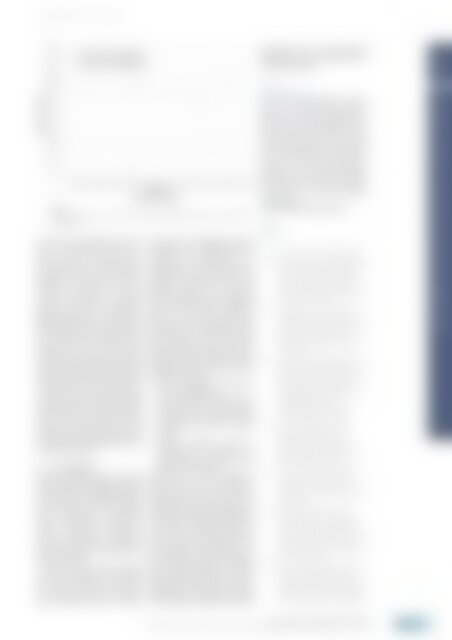You also want an ePaper? Increase the reach of your titles
YUMPU automatically turns print PDFs into web optimized ePapers that Google loves.
<strong>atw</strong> Vol. 62 (<strong>2017</strong>) | Issue 6 ı June<br />
| | Fig. 8.<br />
Ratios of measured Cm-242 data to measured and calculated Am-242 data for the seven samples from<br />
Obrigheim NPP.<br />
two nuclides in equilibrium. The halflives<br />
of Am-242 and Cm-242 are<br />
16.02 hours and 162.8 days, respectively,<br />
and 82.70 % of Am-242 goes<br />
through beta decay to form Cm-242.<br />
Therefore, the measured values for<br />
Cm-242 are expected to be about<br />
200 times larger than the measured<br />
values for Am-242 in equilibrium.<br />
Figure 8 shows the ratios of the measured<br />
Cm-242 values to the measured<br />
and calculated Am-242 values for the<br />
seven samples from Obrigheim NPP.<br />
Although the ratio of the Cm-242<br />
values to the calculated Am-242 values<br />
is around 150, the ratio of the Cm-242<br />
values to the measured Am-242 values<br />
is generally less than 20. Therefore, it<br />
is likely that the measured Am-242<br />
values overestimate the actual quantity<br />
of Am-242 by about 10 times. Detailed<br />
analysis of how the measured Am-242<br />
values were derived from the raw<br />
experimental data to the data provided<br />
in the OECD/NEA SFCOMPO database<br />
seems to be necessary.<br />
4 Conclusions<br />
Nuclide composition data of spent<br />
nuclear fuels such as those provided in<br />
the OECD/NEA SFCOMPO database<br />
are important in many fields including<br />
reactor physics, fuel cycle applications,<br />
radiological consequence<br />
analysis, and nuclear forensics. To<br />
reduce unnecessary uncertainties<br />
associated with nuclide composition<br />
data, the validation of such data is a<br />
high-priority task.<br />
As one of the first steps, a simple<br />
method is proposed for identifying<br />
the nuclide composition data that<br />
may include errors and therefore<br />
require detailed analysis or further<br />
investigation. The proposed method<br />
is based on the ORIGEN-ARP code<br />
calculation, the assumption of a<br />
constant power history, the percentage<br />
differences of the calculated and<br />
measured composition data, and<br />
detailed analysis of the identified<br />
data. The application of the proposed<br />
method to the nuclide composition<br />
data of spent nuclear fuels from<br />
Obrigheim NPP demonstrated that<br />
the method can effectively identify<br />
various possible errors or data that<br />
need to be further investigated. Errors<br />
identified during detailed analysis<br />
or possible errors that require further<br />
investigation include:<br />
• Errors in burnup measurement<br />
(e.g., GEROBRPWR-9)<br />
• Errors in properly considering the<br />
cooling time (e.g., Pu-241/Pu-239)<br />
• Errors in the ratio calculation from<br />
measured data (e.g., Cs-137/<br />
U-238)<br />
• Possible systematic errors in<br />
measurements of isotopic composition<br />
(e.g., Am-241 and Am-242<br />
measurements at Ispra)<br />
Although the nuclide composition<br />
data that were not identified as<br />
needing detailed analysis or further<br />
investigation cannot necessarily be<br />
considered as definitively validated, it<br />
is believed that the proposed method<br />
can identify a significant portion of<br />
the errors in the nuclide composition<br />
data. Despite the simplicity of the<br />
proposed method, it is believed to be a<br />
very efficient method of identifying<br />
those nuclide composition data that<br />
require detailed analysis or further<br />
investigation. For this reason, the proposed<br />
method is expected to be useful<br />
as the first step in validation of nuclide<br />
composition data of spent nuclear<br />
fuels such as those in the OECD/NEA<br />
SFCOMPO database.<br />
Acknowledgements<br />
This work was supported by a grant<br />
from the Nuclear Safety Research<br />
Program of the Korea Foundation of<br />
Nuclear Safety, with funding from the<br />
Korean government's Nuclear Safety<br />
and Security Commission. This work<br />
was also supported by a grant from<br />
the Nuclear Research & Development<br />
Program of the National Research<br />
Foundation of Korea, which is funded<br />
by the Korean government's Ministry<br />
of Science, ICT & Future Planning<br />
(Grant Code: <br />
NRF-2016M2B2A9A02945211).<br />
References<br />
[1] https://www.oecd-nea.org/sfcompo/<br />
[2] Masayoshi Kurosawa, Yoshitaka Naito,<br />
Hiroki Sakamoto and Toshiyuki Kaneko.<br />
The isotopic compositions database<br />
system on spent fuels in light water<br />
reactors (SFCOMPO), JAERI-Data/Code<br />
96-036, Japan Atomic Energy Research<br />
Institute, February 1997.<br />
[3] H. Mochizuki, K. Suyama, Y. Nomura,<br />
H. Okuno. Spent Fuel Composition<br />
Database System on WWW – SFCOMPO<br />
on WWW Ver.2. Japan: Japan Atomic<br />
Energy Research Institute; 2001,<br />
Report no. JAERI-Data/Code 2001-020<br />
[in Japanese].<br />
[4] Yi-Kang Lee. Comparative Analysis of<br />
Isotopic Composition of Spent Fuel from<br />
Takahama-3 PWR PIE database using<br />
TRIPOLI-PEPIN Code, Proceedings of the<br />
ANS Topical Meeting on Reactor<br />
Physics Organized and hosted by the<br />
Canadian Nuclear Society<br />
(PHYSOR-20<strong>06</strong>). Vancouver, BC,<br />
Canada. September 10-14 20<strong>06</strong>.<br />
[5] Ivan Fast, Yuliya Aksyutina, Holger<br />
Tietze-Jaensch. Evaluation and<br />
Parameter Analysis of Burn up<br />
Calculations for the Assessment of<br />
Radioactive Waste, Proceedings of the<br />
WM2013 Conference, Phoenix,<br />
Arizona, USA, February 24-28, 2013.<br />
[6] G. Nicolaou. Discrimination of spent<br />
nuclear fuels in nuclear forensics<br />
through isotopic fingerprinting, Annals<br />
of Nuclear Energy, vol.72, pp.130-133,<br />
October 2014.<br />
[7] Kenya Suyama, Ali Nouri, Hirold<br />
Mochizuk, Yasushi Nomura. Improvements<br />
to SFCOMPO – a Database on<br />
Isotopic Composition of Spent Nuclear<br />
Fuel, Book of extended synopses of the<br />
International conference on storage of<br />
spent fuel from power reactors, Vienna,<br />
Austria, 2-6 Jun 2003.<br />
[8] Ian C. Gauld, Yolanda Rugama. Activities<br />
of the OECD/NEA Expert Group on<br />
Assay Data for Spent Nuclear Fuel, Proceedings<br />
of the International Workshop<br />
on Advances in Applications of Burnup<br />
Credit, Cordoba, Spain, 27-30 Oct 2009.<br />
DECOMMISSIONING AND WASTE MANAGEMENT 407<br />
Decommissioning and Waste Management<br />
Validation of Spent Nuclear Fuel Nuclide Composition Data Using Percentage Differences and Detailed Analysis ı Man Cheol Kim

















